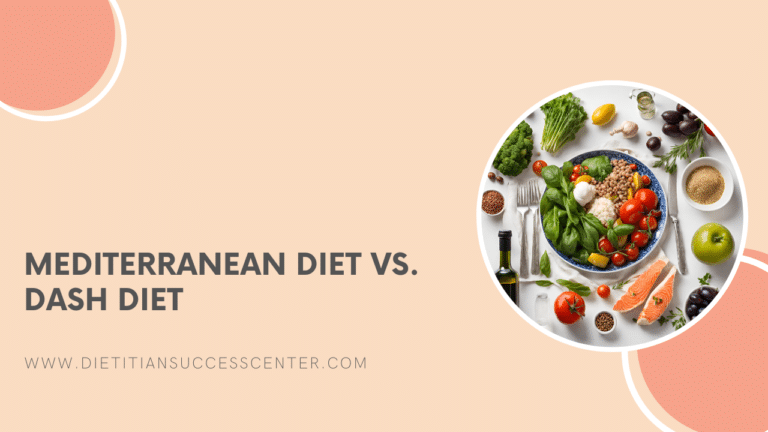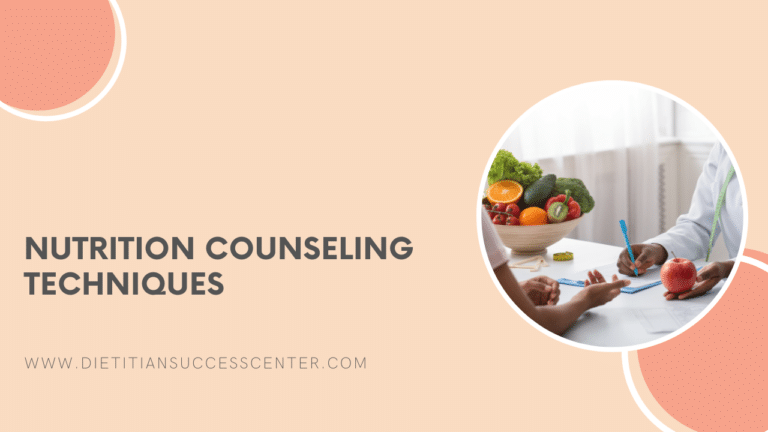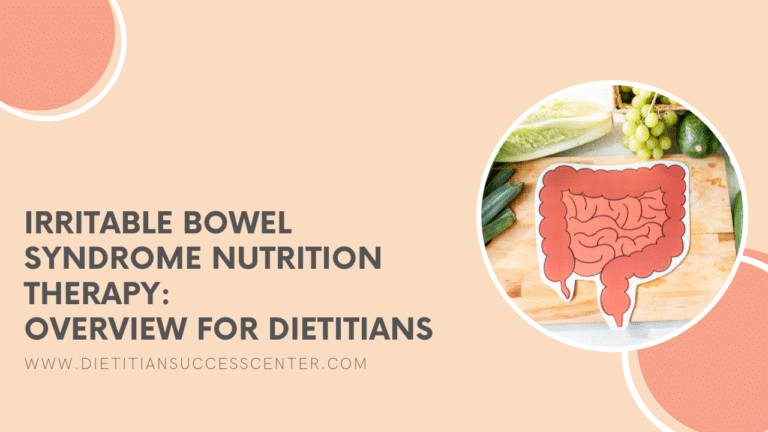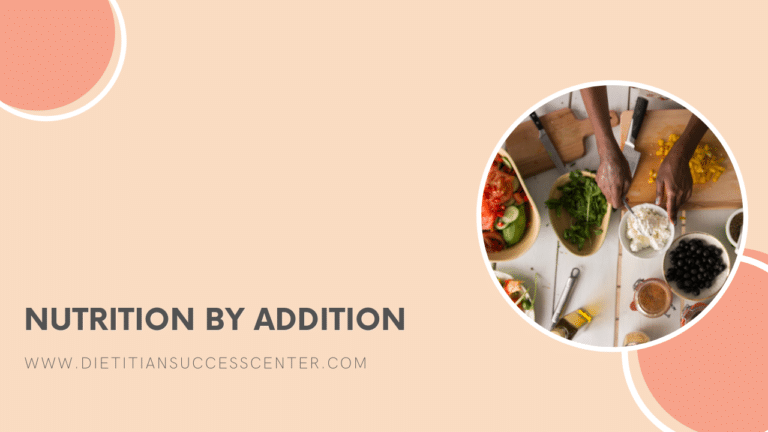

Written by Olivia Farrow, RD, MHSc
Reviewed by Krista Kolodziejzyk, RD, MPH, MBA
Plant-Based Nutrition Guide for Dietitians
Plant-based eating is becoming increasingly popular (1). It’s important for dietitians to understand the various types of plant-based diets and the motivations behind choosing a plant-based diet. Understanding these motivations can help dietitians better understand our patients. Dietitians need to be familiar with nutrients of concern for plant-based, vegan, and vegetarian diets to ensure that we are making appropriate recommendations.
Ready to learn more about plant-based eating? In this article, we share the basics of plant-based nutrition from our Plant-Based Eating Course on Dietitian Success Center (0.75 dietitian ceus).
Definitions of Plant-Based Eating
There are many definitions of plant-based eating and the term “plant-based” can be broad and varied.
Some common definitions of plant-based eating include:
-
- Vegetarian – Often “vegetarian” refers to a “lacto-ovo” vegetarian diet where eggs and dairy products are included. Someone could also be just “lacto-” (includes dairy) or just “ovo-” (includes eggs) vegetarian.
-
- Vegan – Usually those following a vegan diet avoid all animal products including meat, poultry, dairy, eggs and sometimes honey (which is controversial in the vegan community since bees produce it).
-
- Pescatarian – A vegan or vegetarian diet that still includes fish.
-
- Flexitarian – A plant-based diet (meaning, a diet that emphasizes plant-based foods) with no strict rules. This population may avoid or limit meat, poultry, fish, eggs and/or dairy products.
Motivations for Plant-Based Eating
There can be different motivations behind why people want to shift to a plant-based diet, such as:
Animal welfare: This is one of the most common reasons people switch to a plant-based diet. Animal ethics can be a big motivator for avoiding the consumption of meat (2).
Environmental concerns (2): Plant-based foods require less water to grow than animals for their growth and feed production (3). Plant foods also produce lower greenhouse gas emissions for production and transportation than animal foods (4). If individuals are “eating for the environment”, choosing a plant-based diet may be their clearest choice.
Health Benefits: The health benefits of plant-based diets can be a strong motivating factor for choosing this way of eating (2). Some studies suggest that vegetarian diets can reduce the risk of (5):
-
- Hyperlipidemia
-
- Hypertension
-
- Diabetes
-
- Diverticular disease
-
- Chronic kidney failure
-
- Some cancers
These health benefits are related to reduced saturated fat and increased fiber, potassium, and antioxidant consumption associated with an appropriately planned plant-based diet (6). A plant-based diet should include a balanced variety of nutritious plant-based foods and not just highly processed foods that are free from animal products. This is where a dietitian’s role in supporting nutritious plant-based diets is so important.
Nutrients of Concern for Plant-Based Eating
Appropriate planning is where a dietitian can help to support people following a plant-based diet achieve all of the health benefits and nutritional adequacy (6). It is important to evaluate nutritional deficiencies, food restrictions, and individual barriers to optimal nutrition.
The following nutrients of concern should be considered with plant-based diets as they may be more difficult to obtain when eliminating or reducing animal products.
Protein
To begin with, protein is a common concern when transitioning to a vegan or vegetarian diet. However, with appropriate meal planning, meeting daily protein needs is very doable with plant-based protein foods. Plant-based proteins can be less bioavailable than animal-based foods, so it’s recommended that individuals following a vegan or vegetarian diet increase their daily protein intake slightly (7). Including a source of protein at each meal and snack can help to meet protein needs.
Some common sources of plant-based protein include (7):
-
- Soy foods
-
- Legumes
-
- Pumpkin seeds
-
- Whole grains
-
- Hemp hearts
-
- Peas
-
- Peanuts
DSC’s Plant-Based Eating course includes a “20 Sources of Plant-Based Protein” ready-to-use plant-based dietitian client handout with visual examples of protein sources that you can provide to your own clients.
Vitamin B12
Secondly, vitamin B12 is a nutrient that you cannot get on a fully vegan plant-based diet. B12 is only found naturally occurring in animal products. Individuals with low intake of animal products, or those on a fully vegan diet should supplement with vitamin B12 (8). Some plant-based foods are fortified with B12, including:
-
- Soy milk
-
- Nutritional yeast
-
- Fortified cereals
However, the quantities vary and usually fortified foods are not a sufficient substitute for supplementation.
Iron
In similar fashion to protein, iron is also more bioavailable and readily found in animal-based foods.
Some plant-based sources include (9):
-
- Soy foods
-
- Spinach
-
- Swiss chard
-
- Oatmeal
-
- Pumpkin seeds
-
- Dried figs
-
- Molasses
At the same time, pairing iron foods with a vitamin C source can help to increase the absorption of iron. One example of pairing iron and vitamin C would be to add lemon juice (vitamin C) to a spinach (iron) salad.
DSC’s Plant-Based Eating course includes a “20 Sources of Plant-Based Iron” ready-to-use plant-based dietitian client handout with visual examples of protein sources that you can provide to your own clients.
Calcium
Calcium often comes from dairy foods in the diet. Those on a plant-based diet may need to consider including other sources of calcium in their diet. Some plant-based sources of calcium include (10):
-
- Soy milk
-
- Collard greens
-
- Tofu
-
- Kale
-
- Broccoli
-
- Dried figs
-
- Almond butter
-
- Bok choy
-
- Chickpeas
-
- Black beans
Vitamin D
Vitamin D is often found in animal foods, including fish, eggs, and fortified dairy products. Someone on a vegan diet may be at risk for deficiency of vitamin D if they are not obtaining enough vitamin D from sunlight and may require supplementation (6).
Some plant-based food sources of vitamin D include:
-
- Fortified orange juice
-
- UV treated mushrooms
-
- Fortified soy milk
Zinc
Zinc is another nutrient that is typically found in beef, poultry and fish. Those on a plant-based diet may need to be a bit more mindful of including zinc-containing foods in their diet (11).
Some plant-based sources of zinc are:
-
- Tofu
-
- Chickpeas
-
- Lentils
-
- Peanut butter
-
- Mushrooms
-
- Spinach
-
- Oatmeal
-
- Pumpkin seeds
-
- Sunflower seeds
-
- Almonds
-
- Broccoli
Omega-3 Fatty Acids
Omega-3 fatty acids are typically found in fatty fish and omega-3 eggs. In addition to vegans and vegetarians, most people are not consuming enough omega-3 from their diet.
ALA, the plant-based form of omega-3 can be found in (6):
-
- Flax seeds (ground)
-
- Hemp seeds
-
- Chia seeds
-
- Walnuts
-
- Flaxseed oil
Iodine
Iodine is typically found in fish and dairy. Plant-based sources of iodine include iodized salt and sea vegetables (kelp, seaweed, etc.)(6). For many people, including iodized salt is the most practical strategy to achieve sufficient iodine in their diet.
Plant-Based Plate
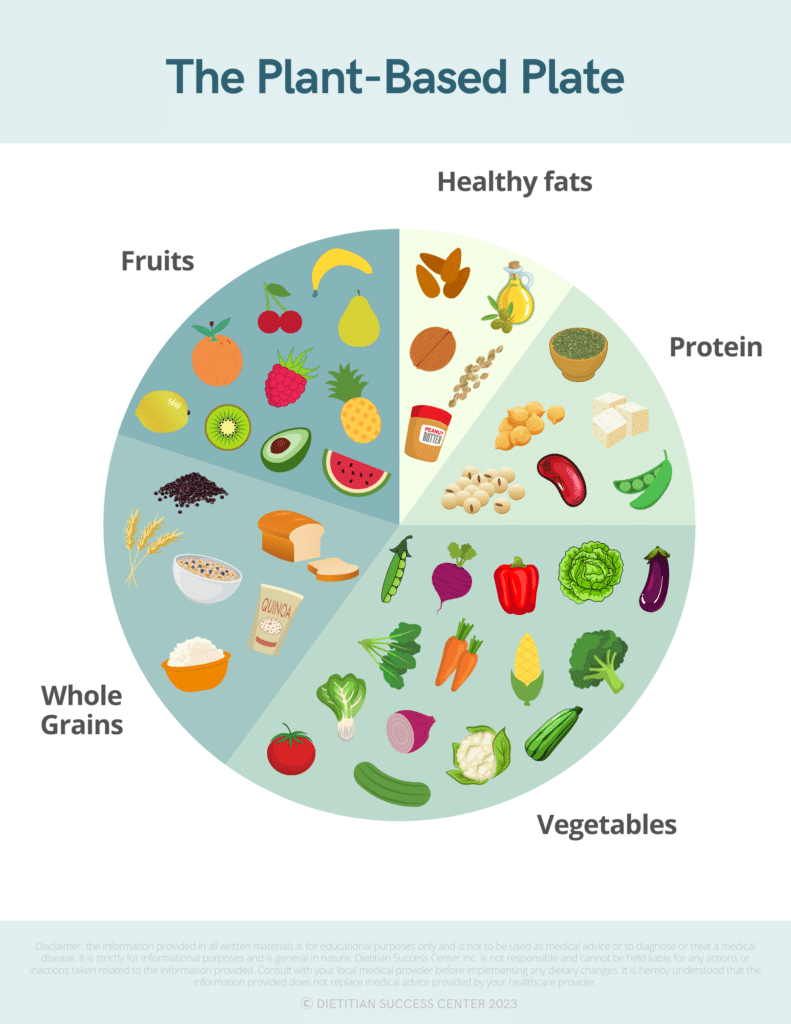
Utilizing a plant-based plate illustration can help to visually explain how to build meals for optimal nutrition. The following infographic demonstrates the approximate proportions of each food group to achieve ideal nutritional balance from a plant-based diet.
Key Takeaways
-
- Plant-based eating is increasing in popularity and there are various forms of plant-based diets.
- People may choose plant-based eating for a variety of reasons including animal ethics, environmental concerns, and health benefits.
- Meal planning to include adequate protein, b12, iron, calcium, vitamin D, zinc, omega-3 and iodine is important for a plant-based diet.
- With some consideration, planning, and support from a registered dietitian, consuming a plant-based diet can be adequate, nutritious and stress-free!
The Dietitian Success Center membership includes access to the Plant-Based Eating course by plant based dietitian Kristin Carli, MS, RD. Learn even more about plant-based nutrition and get access to ready-to-use printable client handouts including:
-
- Easy Plant-Based Meals Recipe Book PDF
-
- Plant Based Plate
-
- 20 Sources of Plant-Based Protein
-
- 20 Sources of Plant-Based Iron
-
- Vegan Sources of Vitamin B12
-
- Greenhouse Gas Emissions
-
- Plant-Based Grocery List
Dietitian Success Center is THE professional development resource for dietitians and dietetic students. Our mission is to make it easier for dietitians and dietetic students to build expertise. We do this through evidence-based online nutrition courses, community and ready-to-use client handouts. Plus – we give you the tools to start and grow your dietitian private practice!
References
1. PR Newswire. 2017. “Top Trends in Prepared Foods 2017: Exploring Trends in Meat, Fish and Seafood; Pasta, Noodles and Rice; Prepared Meals; Savory Deli Food; Soup; and Meat Substitutes,” June 22.
2. Miki, Akari J., Kara A. Livingston, Micaela C. Karlsen, and Sara C. Folta. 2020. “Using Evidence Mapping to Examine Motivations for Following Plant-Based Diets.” Current Developments in Nutrition 4 (3): 1a.
3. Harwatt, Helen, Joan Sabate, Gidon Eshel, Sam Soret, and William Ripple. “Substituting Beans for Beef as a Contribution toward US Climate Change Targets.” Climatic Change 143, no. 1–2 (July 1, 2017): 261.
4. Gardner, Christopher D, Jennifer C Hartle, Rachael D Garrett, Lisa C Offringa, and Arlin S Wasserman. 2019. “Maximizing the Intersection of Human Health and the Health of the Environment with Regard to the Amount and Type of Protein Produced and Consumed in the United States.” Nutrition Reviews 77 (4): 197–215.
5. Oussalah, Abderrahim, Julien Levy, Clémence Berthezène, David H. Alpers, and Jean-Louis Guéant. 2020. “Health Outcomes Associated with Vegetarian Diets: An Umbrella Review of Systematic Reviews and Meta-Analyses.” Clinical Nutrition 39 (11): 3283–3307.
6. Melina, Vesanto, Winston Craig, and Susan Levin. 2016. “Position of the Academy of Nutrition and Dietetics: Vegetarian Diets.” Journal of the Academy of Nutrition and Dietetics 116 (12): 1970–80.
7. Sharon Palmer. 2019. “Protein in Vegetarian and Vegan Diets”. Vegetarian Nutrition Dietary Practice Group Academy of Nutrition & Dietetics.
8. Roman Pawlak. 2017. “Vitamin B12 in Vegetarian Diets.” Vegetarian Nutrition Dietary Practice Group Academy of Nutrition & Dietetics.
9. Jack Norris. 2017. “Iron in Vegetarian Diets”. Vegetarian Nutrition Dietary Practice Group Academy of Nutrition & Dietetics.
10. Virginia Messina. 2014. “Meeting Calcium Recommendations on a Vegan Diet”. Vegetarian Nutrition Dietary Practice Group Academy of Nutrition & Dietetics.
11. Jack Norris. 2014. “Zinc in Vegetarian Diets”. Vegetarian Nutrition Dietary Practice Group Academy of Nutrition & Dietetics.



